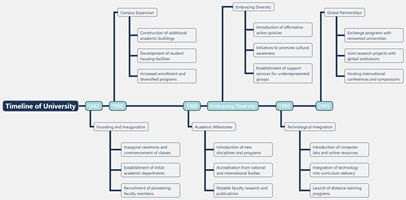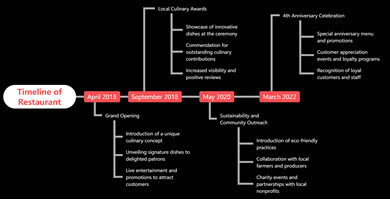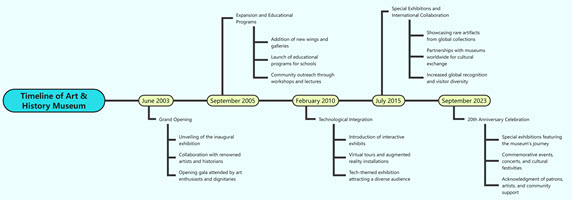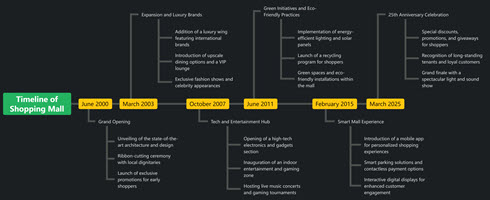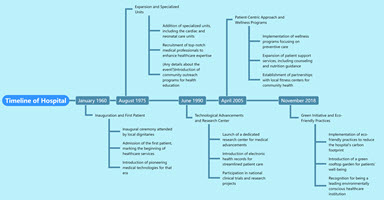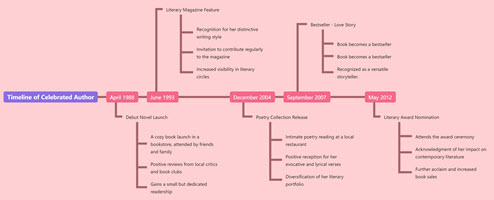What is a Mind map
A mindmap is a visual thinking and learning tool that allows you to organize information in a radial, non-linear manner. It typically starts with a central concept or theme, from which related ideas, facts, and details branch out in an organic, interconnected structure.
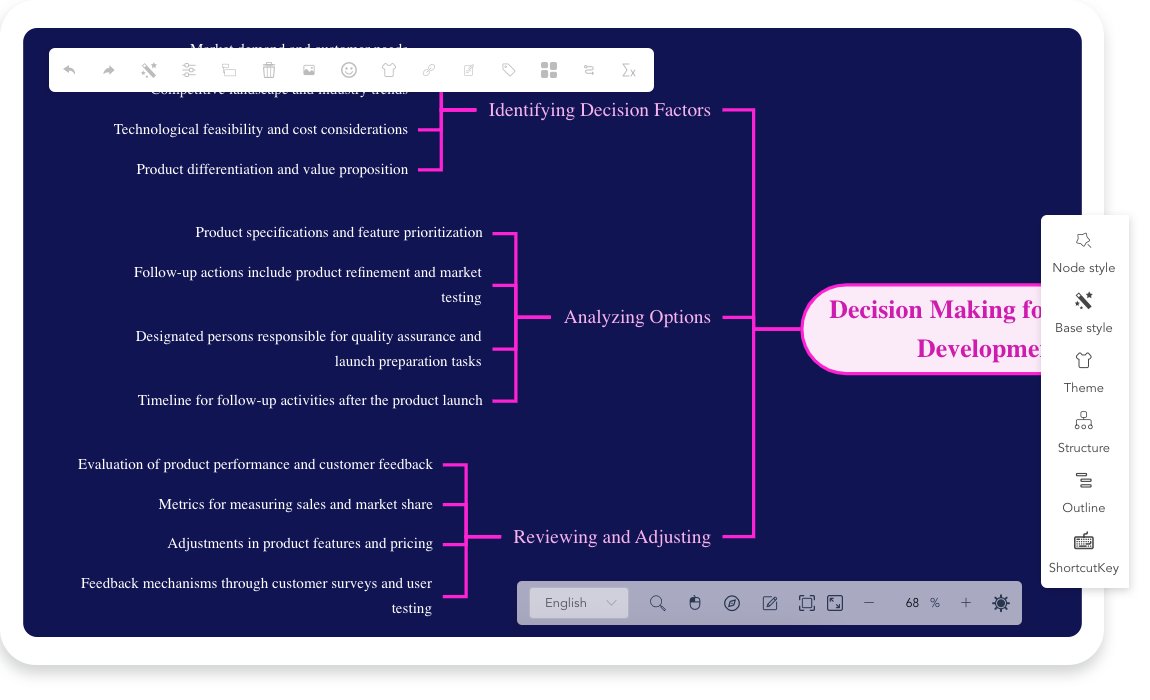
The key benefits of mind mapping include:
- Encouraging free-flowing ideation and brainstorming
- Providing a clear, easy-to-grasp visual representation of complex information
- Promoting understanding of relationships and connections between different elements
- Enabling flexible organization and reorganization of ideas
What is a Timeline
A timeline is a graphical or linear representation of a sequence of events, typically organized chronologically. Timelines are used to visualize the flow of history, the progression of a project, or the key milestones in a process.
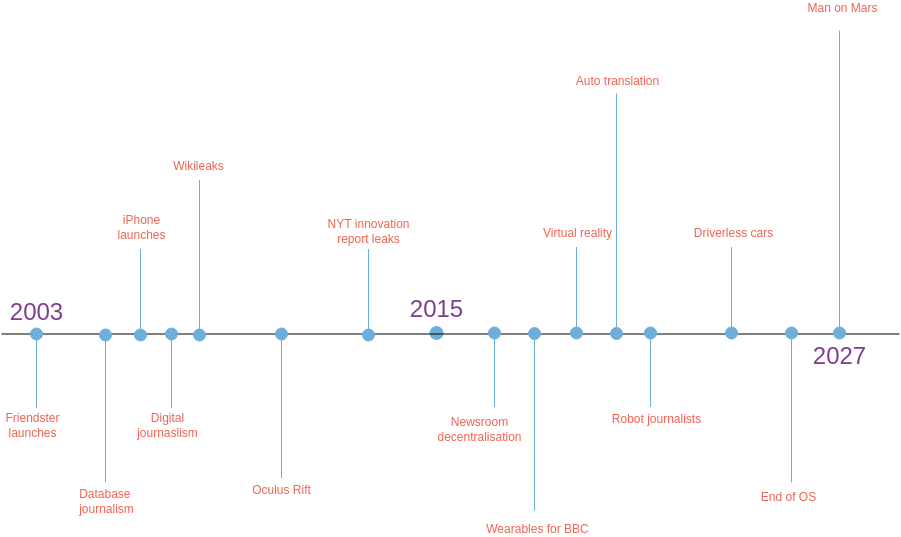
Some of the main advantages of using timelines include:
- Conveying a clear sense of the order and duration of events
- Identifying dependencies, patterns, and trends over time
- Facilitating planning, scheduling, and project management
- Enhancing communication and understanding of complex temporal information
By combining the strengths of mind mapping and timelines, you can create powerful visual tools that effectively organize, communicate, and manage information related to sequences of events, projects, and historical narratives.
Using Mind Maps to Model Timelines Effectively
Mind maps are a powerful visual tool that can be leveraged to create clear and organized timelines. The image provided offers a great example of how a mind map can be used to structure and communicate a timeline effectively.

The Advantages of Mind Mapping for Timelines:
- Brainstorming and Ideation: The open-ended nature of mind mapping encourages free-flowing ideation. As you start mapping out a timeline, you can easily jot down key events, dates, and details without worrying about order or structure initially. This allows you to capture all relevant information before refining the timeline.
- Visual Clarity: By organizing timeline elements in a radial, branching structure, a mind map provides a clear, easy-to-follow visual representation. The hierarchical layout makes it simple to see the relationship between the main timeline milestones and the supporting details. This improves comprehension and retention compared to linear timelines.
- Flexible Structure: Mind maps are inherently flexible, allowing you to easily add, remove, or rearrange timeline elements as needed. This makes them ideal for mapping out timelines that may evolve or require frequent updates.
- Holistic Understanding: The mind map format encourages you to consider the timeline in its entirety. By having all the key details visually organized, you can more easily spot connections, dependencies, and potential gaps in the timeline.
Applying Mind Mapping to Timelines:
- Start with the central theme or event that defines the timeline. In the example, this is represented by the “What is the theme?” node.
- Branch out from the central theme to capture the start date, end date, and major events along the timeline.
- For each major event, add supporting details such as descriptions, locations, or other relevant information.
- Organize the timeline elements in a clear, logical flow, using branches, color-coding, and visual cues to enhance clarity.
- Review the mind map regularly, updating and refining it as the timeline evolves.
By leveraging the brainstorming power and visual structure of mind maps, you can create timelines that are engaging, easy to understand, and highly effective for planning, communication, and project management. The example provided demonstrates how this approach can lead to a comprehensive, yet visually-appealing representation of a timeline.
Case Study – key events and milestones for a restaurant
This image presents a timeline of key events and milestones for a restaurant over the course of several years. The timeline highlights the restaurant’s journey and the strategic initiatives undertaken to drive its growth and success.
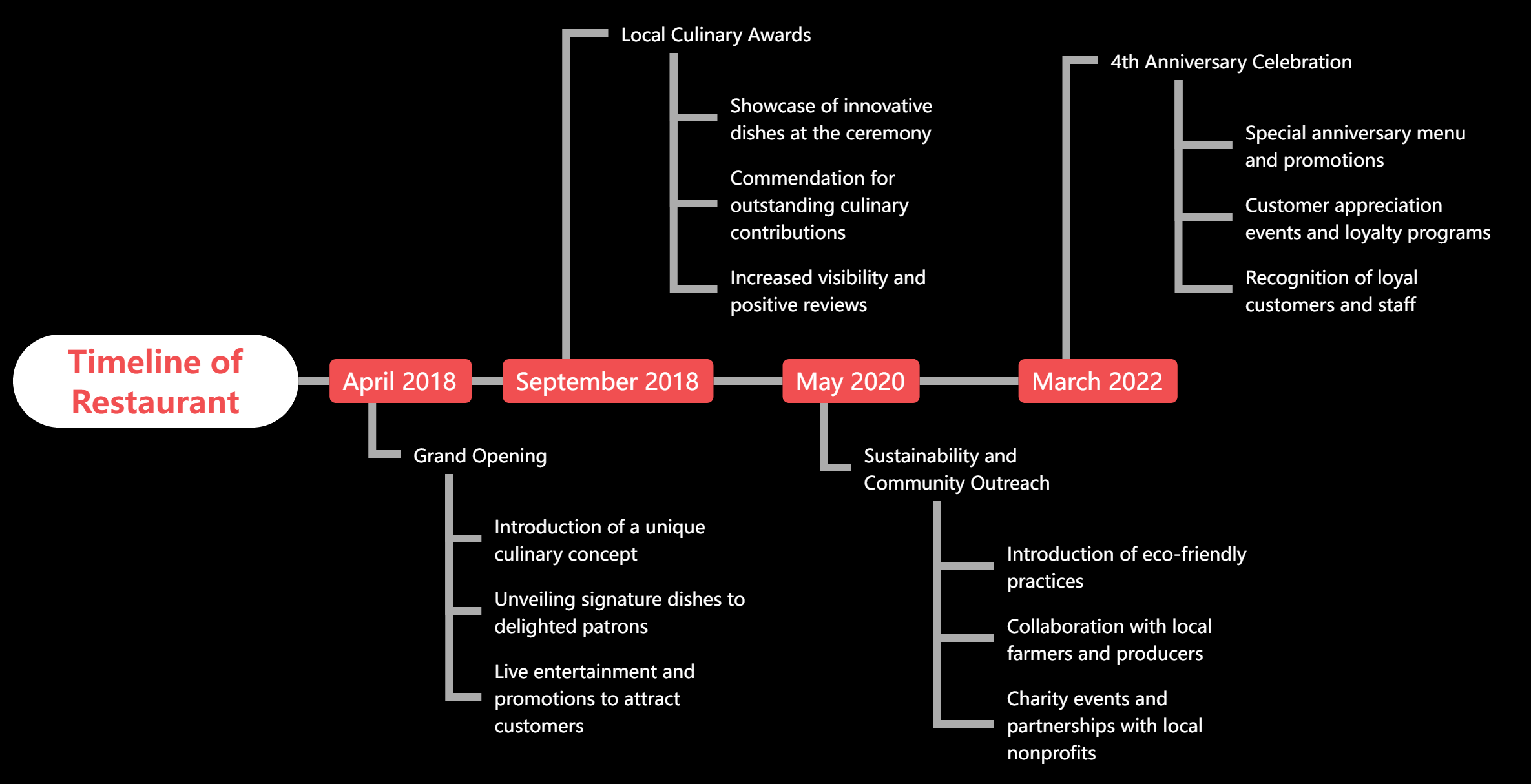
Key Concepts Illustrated:
- Grand Opening (April 2018):
- The restaurant’s initial launch, marking the start of its operations and establishment in the local community.
- This stage focuses on introducing the restaurant’s unique culinary concept and building initial customer awareness and interest.
- Introduction of Unique Culinary Concept (September 2018):
- The restaurant further differentiates itself by unveiling a distinctive culinary offering, likely a specialized menu or unique dishes.
- This step aims to create a memorable dining experience and attract a loyal customer base.
- Local Culinary Awards (May 2020):
- The restaurant’s culinary contributions are recognized through local awards and accolades.
- This recognition enhances the restaurant’s reputation, visibility, and positive reviews, attracting more customers.
- 4th Anniversary Celebration (March 2022):
- The restaurant celebrates a significant milestone in its operations, marking 4 years of success.
- This event is an opportunity to engage with customers, implement special promotions, and recognize loyal staff and patrons.
- Sustainability and Community Outreach:
- The restaurant demonstrates its commitment to sustainability and community involvement.
- Initiatives such as eco-friendly practices, collaborations with local producers, and charity partnerships showcase the restaurant’s broader social and environmental responsibilities.
By strategically planning and executing these milestones, the restaurant has been able to establish a strong brand identity, differentiate its offerings, gain recognition, and engage with its local community. This comprehensive approach, as illustrated in the timeline, has likely contributed to the restaurant’s growth and long-term sustainability.
Recommend Mind Mapping Tool
Unlock the power of seamless mind mapping and visual brainstorming with Visual Paradigm Smart Board – the comprehensive, free-to-use app that will transform the way you organize your ideas and projects.
Experience the Difference of Visual Clarity
SmartBoard’s intuitive mind mapping interface allows you to present key concepts, relationships, and contextual details in a clear, structured manner. Bid farewell to cluttered, linear notes and embrace the power of hierarchical, visually-appealing mind maps.
Effortless Idea Capture and Organization
Whether you’re planning a complex project, contextualizing your thoughts, or solving intricate problems – Smart Board’s robust features make it a breeze. Drag-and-drop functionality, predefined templates, and flexible formatting options empower you to bring your ideas to life.
Personalize Your Visual Journey
Customize the appearance of your mind maps with a wide array of styles, fonts, colors, and themes. Make your visuals truly your own and elevate your presentations, reports, and collaborations.
Collaborate with Ease
Store your mind maps securely in the cloud and share them seamlessly with colleagues, clients, or teammates. Smart Board’s integrated cloud storage ensures your data is accessible anytime, anywhere.
Get Started for Free – No Strings Attached
Experience the transformative power of visual thinking with Smart Board – available completely free, with no hidden charges or credit card requirements. Unlock your creative potential and elevate your productivity today.



